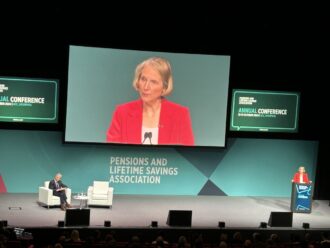It is hard to move around unnoticed when you are big. This applies to defined benefit (DB) schemes in the UK, which collectively manage more than £1.5trn in assets, they are the proverbial elephant in the gilt market room.
DB appetite for longer-dated inflation-linked debt is on the rise, due to rising inflation risks and the hope of many schemes to achieve buy out. But this is pushing yields down, turning linkers into a relatively expensive weapon to shield portfolios from price rises. With UK CPI inflation at 5.5% and expected to hit 8% by the end of the first quarter, it is no wonder that demand for interest rate and inflation hedges is on the rise.
As of the final three months of 2021, inflation hedging activity increased by 24% and those for interest rates by 27%, quarter-on-quarter, according to BMO Global Asset Management.
Linkers
This demand is partially driven by the prospect of rising interest rates and price levels, but also by a significant proportion of DB scheme assets to be held in linkers if they are to achieve a buyout. Almost half of all such schemes are preparing for a buyout, some 39% during the next five years.
At the same time, issuance of index-linked bonds has remained relatively unchanged, at £486.1bn in December, compared to £454.2bn the previous year, accounting for 12% of all new gilts issued, according to the Debt Management Office (DMO).
To put this into perspective, DB liabilities stand at £1.7trn, so linkers would only cover around a quarter of all liabilities. Moreover, linkers tend to tail market movements in growth assets, said John Roe, head of multi-asset at LGIM.
“As equities values rise, it improves scheme funding levels and more of them de-risk, increasing demand for matching assets like linkers, which in turn pushes down their yields and increases their prices. It’s a case of the pension behemoth wagging the linker tail,” he added.
The combination of these factors makes linkers a relatively expensive option to hedge inflation risks. A case in point was the issuance of inflation-linked gilts with a 50-year maturity in 2021. Britain’s government sold more of the debt than expected, raising £3.9bn, as investors were willing to pay far more than its par value. The linkers were issued at a record low yield of -2.38% and received £17.5bn in orders. So, given the high costs of linkers, what do investors see as the alternative?
Corporate debt/private credit
To avoid the constraints of linkers, some investors opt for inflation-linked corporate bonds or private debt instead. Some 20% of DB investors consider private debt as an alternative to bonds, while corporate bonds account for 40% of the average DB fixed income portfolio, according to Mercer’s Asset Allocation Survey.
USS, for example, has expanded its fixed income and private markets teams and announced a series of investments in inflation-linked private debt. This includes £100m in inflation linked debt with Severn Trent Water. “
We look for investments that will deliver a good mix of long-term growth potential and also hedge against the risks of higher inflation in the future,” said USS’ chief investment officer, Simon Pilcher.
Equities
Others see equities as the best alternative. Jason Fletcher, chief investment officer at London CIV argues that over time “equities, probably do a fairly good job of matching inflation”. The £44bn local government pension scheme pool has just over £11bn invested in equities.
“My view is that it is actually good for equities when inflation moves from zero to 4%. That’s a great time to own equities. The big question in history is what happens when inflation goes over 4%, suddenly it gets a bit dodgy. But in the end, even if inflation will go above 4% and equities will not match inflation, I’m pretty sure they will beat bonds.”
Real assets
But Fletcher acknowledges that not all partner funds at CIV share his stance on equities. One of the pool’s most popular strategies in recent times is the Inflation Plus Fund, which targets above inflation returns from property. This ties in with a broader interest in real assets as an inflation hedge.
GLIL Infrastructure, for example, has grown rapidly following increased institutional demand and has now hit £2.5bn. Similarly, the BT Pension Scheme has £3.8bn, or 7% of its portfolio, invested in property, including investments in Kings Cross Estate, and another £1.5bn in infrastructure.
The scheme has increased its hedge ratio against interest rate and inflation risks to 85% and 78%, respectively, using a combination of inflation linked bonds, and inflation and interest rate derivatives. But while alternative inflation hedges have become a growing part of DB scheme portfolios, the fact that most schemes are closed to further accrual and many are winding down, means that bonds will continue to remain a cornerstone of their portfolio.
More than half of DB investors say that there is no alternative to government bonds for the defensive part of their portfolio, according to Mercer. This means that investor appetite for linkers will continue to grow, despite the challenges.





Comments